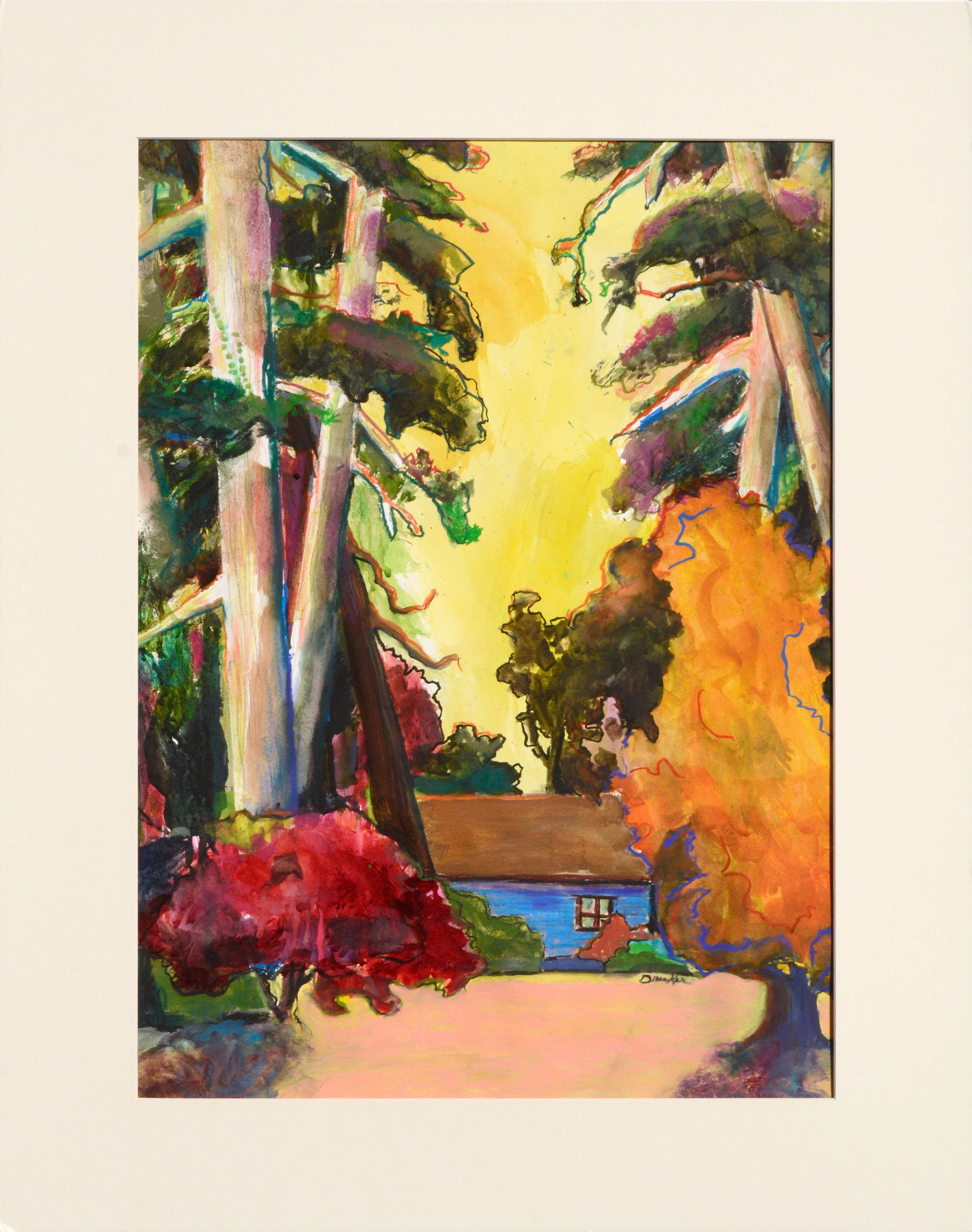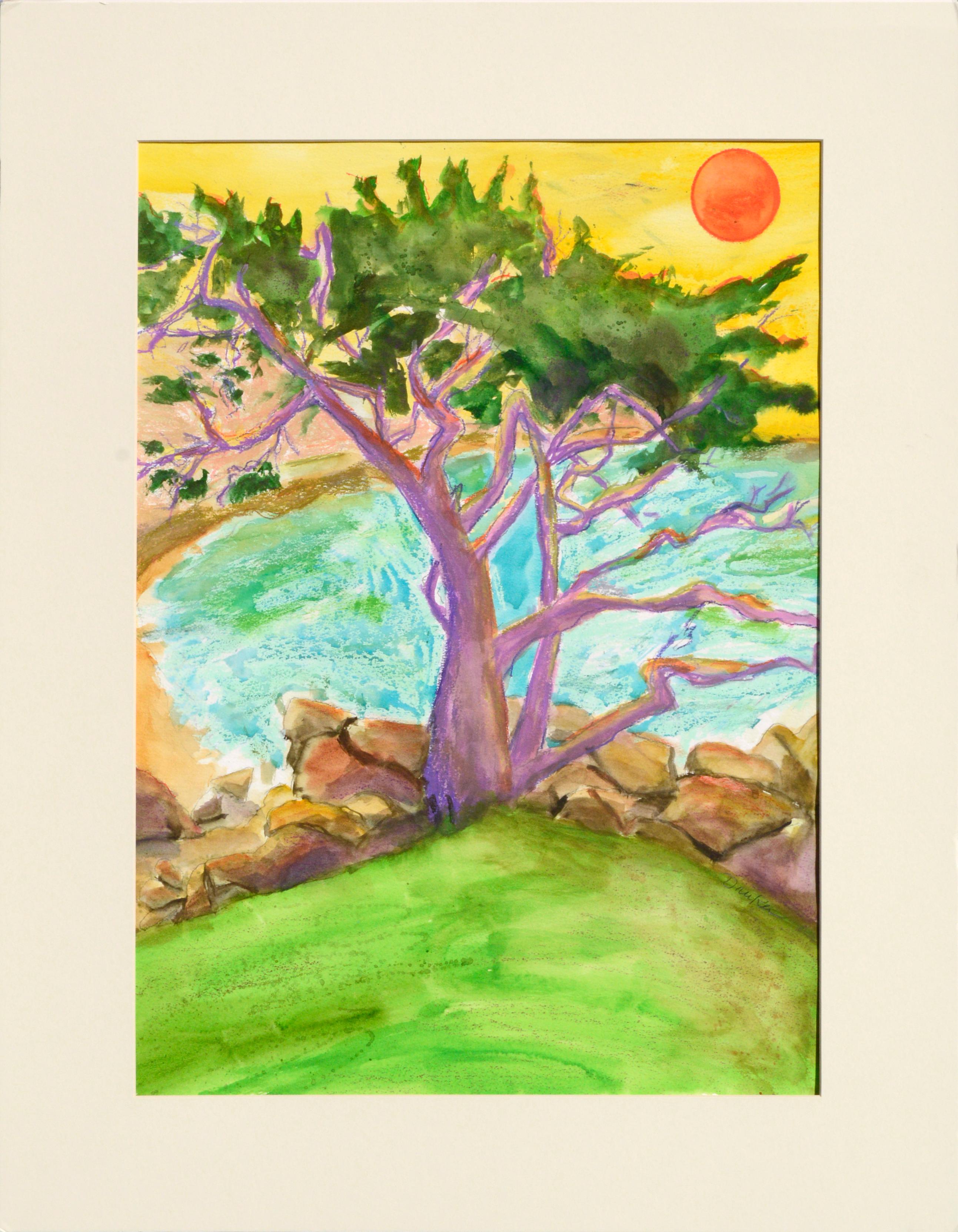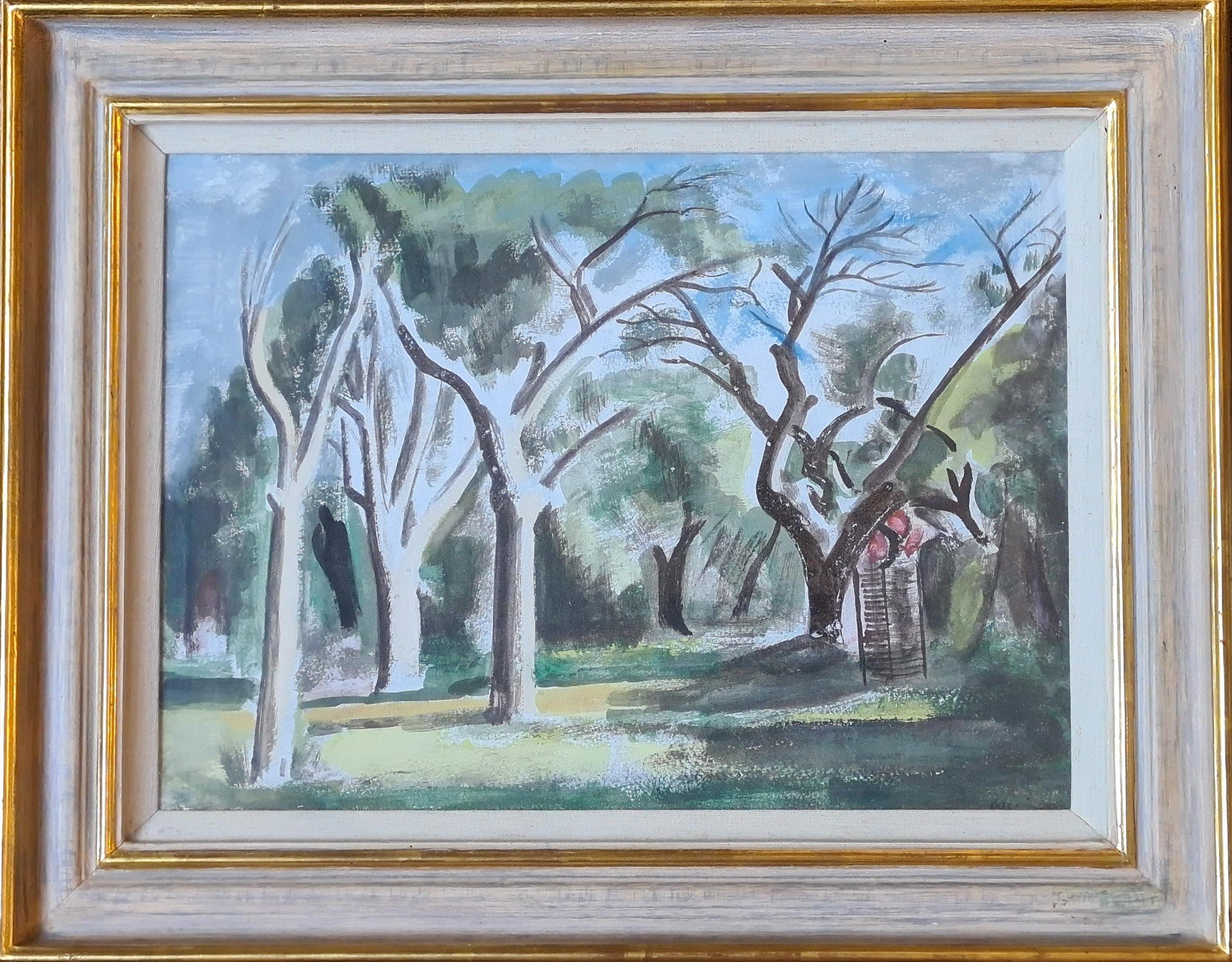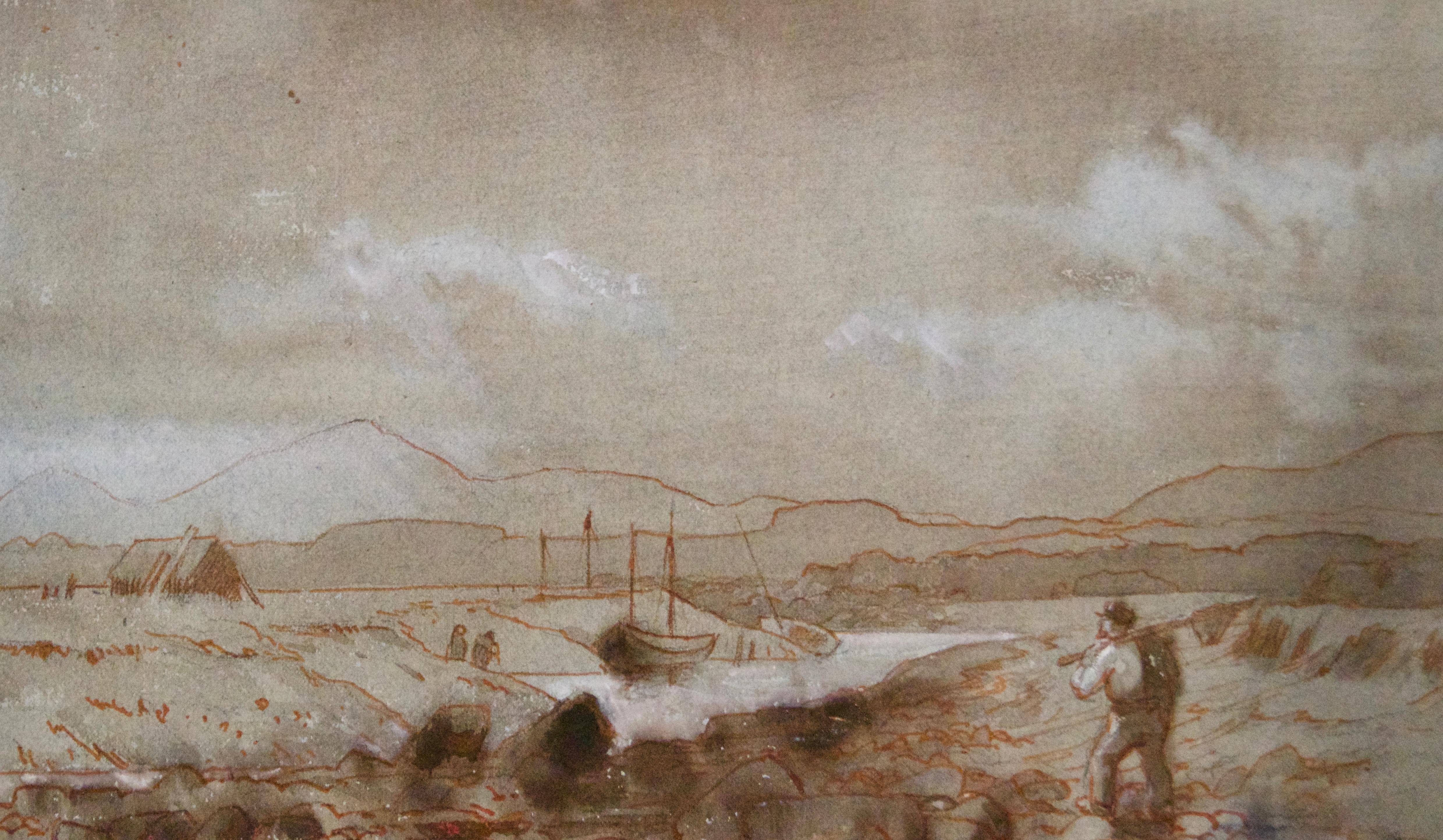Louis Wolchonok"Gondolas at the Dock, Venice, Italy" Louis Wolchonok, Boats in the Harbor Scene1928
1928
About the Item
- Creator:Louis Wolchonok (1898 - 1973, American)
- Creation Year:1928
- Dimensions:Height: 24.5 in (62.23 cm)Width: 30.5 in (77.47 cm)
- Medium:
- Movement & Style:
- Period:
- Condition:
- Gallery Location:New York, NY
- Reference Number:1stDibs: LU184129905412
Louis Wolchonok
Louis Wolchonok was an author of art books, etcher, painter of townscapes, landscapes, figures, muralist and graphic artist. Wolchonok was a social realist artist who worked in watercolors, oils and prints. He studied at the National Academy of Design, The Cooper Union, the City College of New York, Académie Julian in Paris, and the Brooklyn Academy of Fine Arts. He taught drafting at the City College of New York from 1930; and design, painting and etching at the Craft Students League, YWCA, New York, from 1932. He authored The Art of Three Dimensional Design: How to Create Space Figures, Lessons in Pictorial Composition and Design for Artist and Craftsmen.
- ShippingRetrieving quote...Ships From: Larchmont, NY
- Return PolicyA return for this item may be initiated within 3 days of delivery.
- "New York Yankees World Series Celebration, " Kamil Kubik Baseball Street ParadeBy Kamil KubikLocated in New York, NYKamil Kubik (1930 - 2011) The New York Yankees 1998 Baseball World Series Celebration, 1998 Pastel on paper Sight 26 x 19 1/2 inches Provenance: The artist's estate The 1998 New York Yankees were one of the best baseball teams ever, comprising players such as Jorge Posada, Tino Martinez, Chuck Knoblauch, Scott Brosius, Derek Jeter...Category
1990s Post-Impressionist Landscape Paintings
MaterialsOil Pastel, Paper
- "Park Street Church, Boston, " John Whorf Impressionist Watercolor WPA CityscapeBy John WhorfLocated in New York, NYJohn Whorf (1903 - 1959) Park Street Church, Boston, circa 1930-45 Watercolor on paper 21 x 15 inches Signed lower right Housed in its original frame Provenance: Milch Gallery, New ...Category
1930s American Impressionist Landscape Drawings and Watercolors
MaterialsWatercolor, Paper
- "Tugboat at Dock, " Reginald Marsh, Modern WPA Industrial ShipBy Reginald MarshLocated in New York, NYReginald Marsh Tugboat at Dock, circa 1937 Signed lower right Watercolor and pencil on paper 13 3/4 x 20 inches Housed in a Lowy frame. Provenance: Sotheby'...Category
1930s Modern Landscape Paintings
MaterialsPaper, Watercolor, Pencil
- "Old Adobe Village, New Mexico" Alice Schille, Taos Pueblo, Female ImpressionistBy Alice SchilleLocated in New York, NYAlice Schille Old Adobe Village, New Mexico Signed lower right Watercolor on paper 5 x 6 inches Provenance: Estate of the artist Keny and Johnson Gallery, Columbus, Ohio Santa Fe East Galleries, Santa Fe, New Mexico Private Collection, California A painter in watercolor and oil, Alice Schille was a prolific artist using modernist styles of Post-Impressionism, Pointillism and Fauvism. Her subjects included portraits of women and children, landscapes with and without figures, a series of scenes of New York City. New Mexico, and Gloucester, Massachusetts. Her paintings also reflected her widespread international travels in Europe, North Africa, Russia, the Middle East, Mexico, and Guatemala. Although personally very shy, Schille possessed unusual courage and strength of will, which was reflected in both her independent lifestyle and in her work, as she continually worked to master new modes of painting throughout her career. A German critic once referred to Schille as "this daredevil disciple of art who is interested in anything and afraid of nothing." Alice Schille was born in Columbus, Ohio to a family supported by her father's success in manufacturing. She was raised in Columbus, and by the time she was age six, she determined to be an artist. She graduated at the top of her class from Central High School in 1887, studied from 1891 to 1893 at the Columbus Art School, and returned there as a teacher from 1902 to 1948. Going to New York City as a young woman, she enrolled in the Art Students League from 1897 to 1899 and then the New York School of Art with William Merritt Chase and Kenyon Cox. (Some years later, she attended Chase's Shinnecock Summer School on Long Island). From 1903 to 1904, Alice Schille was in Paris at the Academie Colarosi, and also studied privately with Raphael Collin, Rene Prinet, Gustave Courtois and Chase, who was then in Europe. In 1904, five of her paintings were accepted for exhibition at Societe Nationale des Beaux Arts, and from that time on her work was included regularly in important American annual exhibitions including the Pennsylvania Academy, the Corcoran Gallery, American Watercolor Society, Boston Art Club, and the 1987 inaugural exhibition of the National Museum of Women in the Arts in Washington DC. Between 1905 and 1914, Alice Schille painted in Europe, and during the summers of 1916 to 1918, worked in New York and Gloucester. In 1919, she was in New Mexico. On this trip, her first to the Southwest, she spent a summer in Taos and Santa Fe and painted scenes including the Taos Pueblo, Canyon Road and local Hispanic and Indian figures. Reportedly the Ranchos de Taos Church was one of her favorite subjects. Many of these New Mexico paintings were hung at annual exhibitions of the Philadelphia Water Color Club. Between 1920 and 1940, she traveled frequently in the summers, returning to New Mexico and going to Central America and Africa. In 1922, she began her first series of North-African watercolors...Category
1920s American Impressionist Landscape Drawings and Watercolors
MaterialsPaper, Watercolor
- "Train Station, " Max Kuehne, Industrial City Scene, American ImpressionismBy Max KuehneLocated in New York, NYMax Kuehne (1880 - 1968) Train Station, circa 1910 Watercolor on paper 8 1/4 x 10 1/4 inches Signed lower right Provenance: Private Collection, Illinois Max Kuehne was born in Halle, Germany on November 7, 1880. During his adolescence the family immigrated to America and settled in Flushing, New York. As a young man, Max was active in rowing events, bicycle racing, swimming and sailing. After experimenting with various occupations, Kuehne decided to study art, which led him to William Merritt Chase's famous school in New York; he was trained by Chase himself, then by Kenneth Hayes Miller. Chase was at the peak of his career, and his portraits were especially in demand. Kuehne would have profited from Chase's invaluable lessons in technique, as well as his inspirational personality. Miller, only four years older than Kuehne, was another of the many artists to benefit from Chase's teachings. Even though Miller still would have been under the spell of Chase upon Kuehne's arrival, he was already experimenting with an aestheticism that went beyond Chase's realism and virtuosity of the brush. Later Miller developed a style dependent upon volumetric figures that recall Italian Renaissance prototypes. Kuehne moved from Miller to Robert Henri in 1909. Rockwell Kent, who also studied under Chase, Miller, and Henri, expressed what he felt were their respective contributions: "As Chase had taught us to use our eyes, and Henri to enlist our hearts, Miller called on us to use our heads." (Rockwell Kent, It's Me O Lord: The Autobiography of Rockwell Kent. New York: Dodd, Mead and Co., 1955, p. 83). Henri prompted Kuehne to search out the unvarnished realities of urban living; a notable portion of Henri's stylistic formula was incorporated into his work. Having received such a thorough foundation in art, Kuehne spent a year in Europe's major art museums to study techniques of the old masters. His son Richard named Ernest Lawson as one of Max Kuehne's European traveling companions. In 1911 Kuehne moved to New York where he maintained a studio and painted everyday scenes around him, using the rather Manet-like, dark palette of Henri. A trip to Gloucester during the following summer engendered a brighter palette. In the words of Gallatin (1924, p. 60), during that summer Kuehne "executed some of his most successful pictures, paintings full of sunlight . . . revealing the fact that he was becoming a colorist of considerable distinction." Kuehne was away in England the year of the Armory Show (1913), where he worked on powerful, painterly seascapes on the rocky shores of Cornwall. Possibly inspired by Henri - who had discovered Madrid in 1900 then took classes there in 1906, 1908 and 1912 - Kuehne visited Spain in 1914; in all, he would spend three years there, maintaining a studio in Granada. He developed his own impressionism and a greater simplicity while in Spain, under the influence of the brilliant Mediterranean light. George Bellows convinced Kuehne to spend the summer of 1919 in Rockport, Maine (near Camden). The influence of Bellows was more than casual; he would have intensified Kuehne's commitment to paint life "in the raw" around him. After another brief trip to Spain in 1920, Kuehne went to the other Rockport (Cape Ann, Massachusetts) where he was accepted as a member of the vigorous art colony, spearheaded by Aldro T. Hibbard. Rockport's picturesque ambiance fulfilled the needs of an artist-sailor: as a writer in the Gloucester Daily Times explained, "Max Kuehne came to Rockport to paint, but he stayed to sail." The 1920s was a boom decade for Cape Ann, as it was for the rest of the nation. Kuehne's studio in Rockport was formerly occupied by Jonas Lie. Kuehne spent the summer of 1923 in Paris, where in July, André Breton started a brawl as the curtain went up on a play by his rival Tristan Tzara; the event signified the demise of the Dada movement. Kuehne could not relate to this avant-garde art but was apparently influenced by more traditional painters — the Fauves, Nabis, and painters such as Bonnard. Gallatin perceived a looser handling and more brilliant color in the pictures Kuehne brought back to the States in the fall. In 1926, Kuehne won the First Honorable Mention at the Carnegie Institute, and he re-exhibited there, for example, in 1937 (Before the Wind). Besides painting, Kuehne did sculpture, decorative screens, and furniture work with carved and gilded molding. In addition, he designed and carved his own frames, and John Taylor Adams encouraged Kuehne to execute etchings. Through his talents in all these media he was able to survive the Depression, and during the 1940s and 1950s these activities almost eclipsed his easel painting. In later years, Kuehne's landscapes and still-lifes show the influence of Cézanne and Bonnard, and his style changed radically. Max Kuehne died in 1968. He exhibited his work at the National Academy of Design, the Art Institute of Chicago, the Carnegie Institute in Pittsburgh, the Memorial Art Gallery of the University of Rochester, and in various New York City galleries. Kuehne's works are in the following public collections: the Detroit Institute of Arts (Marine Headland), the Whitney Museum (Diamond Hill...Category
1910s American Impressionist Landscape Drawings and Watercolors
MaterialsPaper, Watercolor
- "Monhegan Island, Maine, " Edward Dufner, American Impressionism Landscape ViewBy Edward DufnerLocated in New York, NYEdward Dufner (1872 - 1957) Monhegan Island, Maine Watercolor on paper Sight 16 x 20 inches Signed lower right With a long-time career as an art teacher and painter of both 'light' and 'dark', Edward Dufner was one of the first students of the Buffalo Fine Arts Academy to earn an Albright Scholarship to study painting in New York. In Buffalo, he had exchanged odd job work for drawing lessons from architect Charles Sumner. He also earned money as an illustrator of a German-language newspaper, and in 1890 took lessons from George Bridgman at the Buffalo Fine Arts Academy. In 1893, using his scholarship, Dufner moved to Manhattan and enrolled at the Art Students League where he studied with Henry Siddons Mowbray, figure painter and muralist. He also did illustration work for Life, Harper's and Scribner's magazines. Five years later, in 1898, Dufner went to Paris where he studied at the Academy Julian with Jean-Paul Laurens and privately with James McNeill Whistler. Verification of this relationship, which has been debated by art scholars, comes from researcher Nancy Turk who located at the Smithsonian Institution two 1927 interviews given by Dufner. Turk wrote that Dufner "talks in detail about Whistler, about how he prepared his canvasas and about numerous pieces he painted. . . A great read, the interview puts to bed" the ongoing confusion about whether or not he studied with Whistler. During his time in France, Dufner summered in the south at Le Pouleu with artists Richard Emil Miller...Category
Early 20th Century American Impressionist Landscape Drawings and Waterco...
MaterialsPaper, Watercolor
- The Blue Cabin - Vertical LandscapeBy Karen DrukerLocated in Soquel, CABrightly colored landscape of a cabin in the woods by Karen Druker (American, 1945). Signed "Druker" in the lower right corner. Presented in a cream mat. No frame. Image size: 30"H x...Category
21st Century and Contemporary Fauvist Landscape Drawings and Watercolors
MaterialsPaper, Pastel, Watercolor
- Purple Cypress Tree - Coastal Fauvist Vertical LandscapeBy Karen DrukerLocated in Soquel, CABrightly colored Fauvist coastal landscape of a vivid purple cypress tree at the edge of the water, under a bright yellow sky and orange sun by Karen Druker (American, 1945). Signed ...Category
21st Century and Contemporary Fauvist Landscape Drawings and Watercolors
MaterialsPaper, Pastel, Watercolor, Pencil
- Cookham Dean, A Post Impressionist Landscape, Homage to CezanneBy Bernard MeninskyLocated in Cotignac, FRAn English Post Impressionist gouache of trees in a landscape by noted artist Bernard Meninsky. The painting is signed bottom right and presented in a very fine custom patinated and gilt frame with cloth insert, under glass. There is an exhibition label to the back of the frame, giving the painting's location 'Cookham Dean' in Berkshire near the home of noted contemporary of Meninsky, Stanley Spencer. Provenance: The Boydell Galleries, Liverpool. A charming work when Meninsky was clearly showing the influence and his love for the paintings of Cezanne. The simplification of forms, as well as the flattening of landscape and the use of colour to give perspective. An earlier work by Meninsky but important in his artistic journey to his evolving style. Bernard Meninsky (25 July 1891–12 February 1950) was a British painter of figures and landscapes in oils, watercolour and gouache, a draughtsman and a teacher. Meninsky was born in Konotop, modern-day Ukraine, where his father was a tailor and the family were Yiddish-speaking Ukrainian Jews. They moved to Liverpool when Bernard was six weeks old. Although Meninsky left school at the age of eleven, his talent for art was demonstrated by the sale of a drawing to a local comic postcard business. While working as an errand boy during the day, he attended free classes in art in the evenings, and these enabled him to gain a place at the Liverpool School of Art. He studied there from 1906 to 1911, being financed by a succession of scholarships. He attended summer courses at the Royal College of Art, London, in August 1909 and August 1910, and in 1911 he won a scholarship to study at the Académie Julian in Paris for three months. With financial support from the Liverpool Jewish community and the Jewish Educational Aid Society (JEAS), Meninsky studied at the Slade School of Fine Art in London in 1912. His contemporaries there included David Bomberg, Isaac Rosenberg...Category
Early 20th Century Post-Impressionist Landscape Paintings
MaterialsWatercolor, Gouache, Paper
- La Baie des Anges a Nice et le Casino 1928 gouache Palm Trees, Horse & CarriageBy Raoul DufyLocated in Rancho Santa Fe, CALa Baie des Anges a Nice et le Casino is a lovely gouache on paper from 1928. The work is fully authenticated by Fanny Guillon-Laffaille and is listed in the Raoul Dufy Catalogue Rai...Category
1920s Post-Impressionist Landscape Paintings
MaterialsGouache, Archival Paper
- Pool ShadowsBy Millard SheetsLocated in Miami, FLSigned M. Sheets lower left, Sheets is a masterful craftsman rooted in sound academic training but displays a loose post-impressionist style that does homage to Gaugain. Best viewed...Category
1970s Post-Impressionist Landscape Drawings and Watercolors
MaterialsPencil, Watercolor
- Country Landscape - Late 19th Century Countryside Painting by Lewis George FryBy Lewis George FryLocated in Watford, HertfordshireLewis George Fry (1860 - 1933) Lewis George Fry was a British painter who was born in 1860 in Clifton, Bristol UK. This piece was created with mixed media and is in a gilt frame un...Category
Late 19th Century Post-Impressionist Landscape Drawings and Watercolors
MaterialsMixed Media, Watercolor






